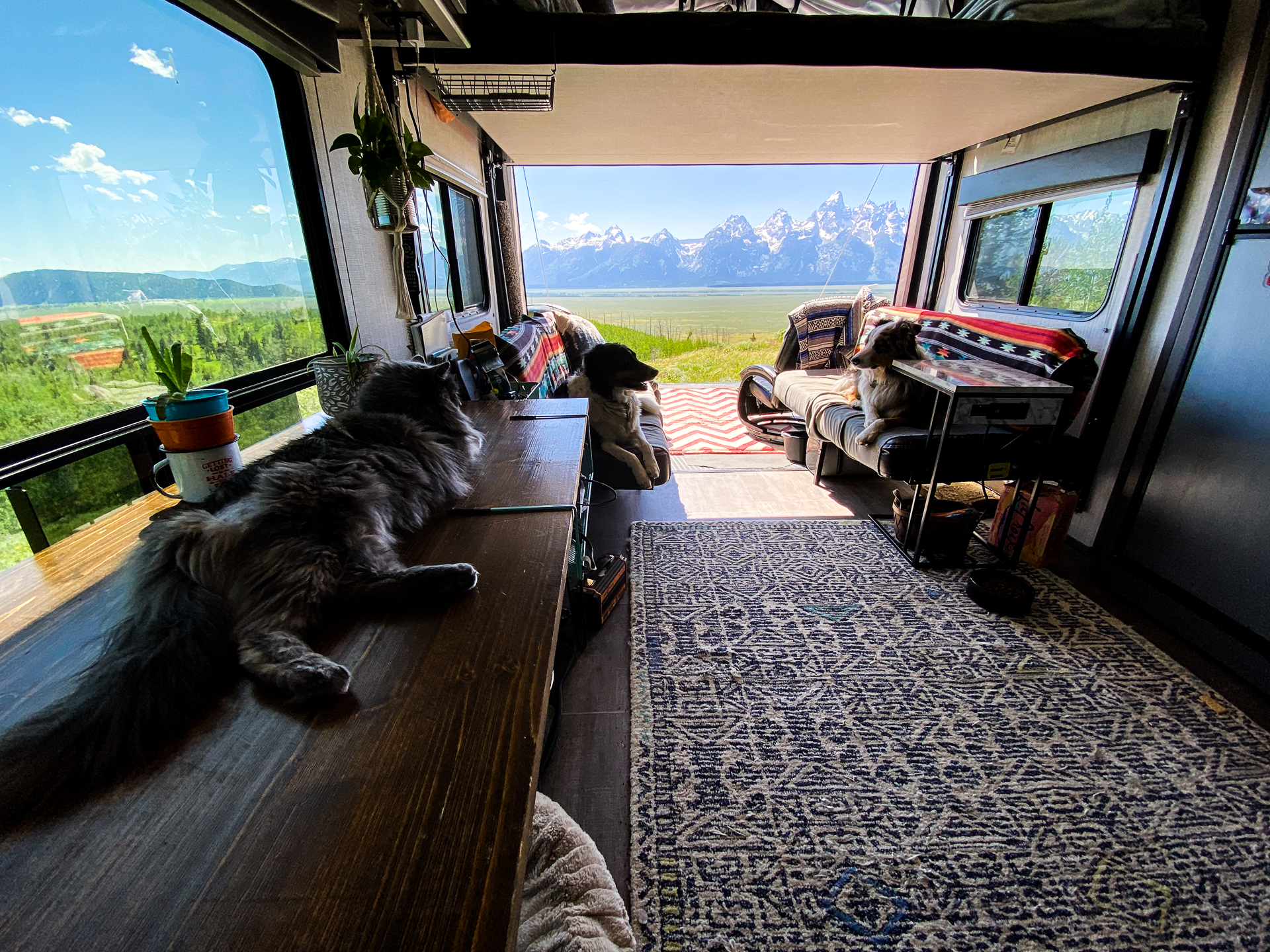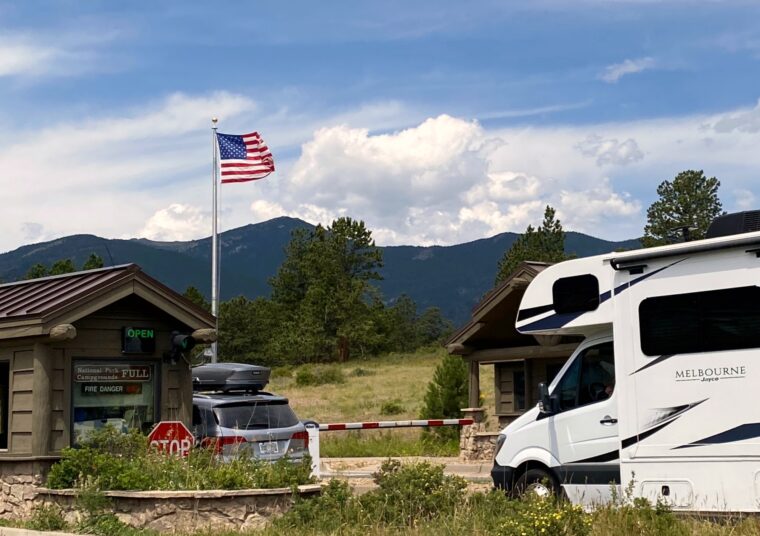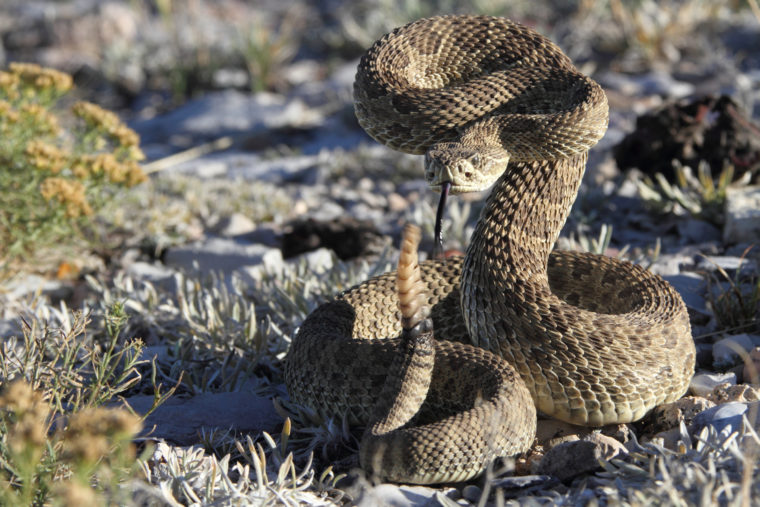If you’re a pet-loving RVer, you know that adventures are usually more fun when your furry friends come along for the ride. One of the best things about boondocking is that you can spread out and roam the vast, serene landscape—and your pets can explore and enjoy the experience with you. Before you head out on your next boondocking excursion, here are a few tips and considerations to keep in mind if a pet is traveling with you.
Make Boondocking Easier With These 5 Things

Considerations When Boondocking With Pets
Part of the appeal of boondocking with pets is that it offers fewer constraints than a traditional campground. Many public land boondocking locations allow pets to be off-leash if they can be controlled under voice command and are generally well trained.
Before you give Fido total freedom, it’s important to make sure your pet has excellent recall skills and that you keep an eye on them at all times. If you’re not confident they will stay with you or obey commands, then you should consider keeping them leashed while boondocking for their own safety in the wild.
Veterinarian Brittany Wolfe, DVM at HomeVets, explains that some situations always call for a leash. “For hiking, I always recommend keeping your dog on a leash at all times. Harnesses are a great option for more advanced hikes in case you need to help lift your dog up difficult terrain.”
While your pet may be used to the wildlife at traditional campgrounds, boondocking in the wilderness can be a different story. You should also always be aware and on alert for predators in the area or animals that your pet may chase after, like squirrels or rabbits.
Properly Disposing of Your Pet’s Waste
When boondocking, you typically don’t have access to dumpsters, so having a plan for your pet’s waste is important. One way to do this is to bag the waste (including cat litter) and set it outside your rig—a tailgate dumpster can come in handy here—until you leave your site and can dispose of it at a gas station, rest area, or at the next campground.
With proper precautions, you can also bury your pet’s waste in the wilderness as long as it’s away from water sources. According to Leave No Trace principles, “Pet waste can be bagged and packed out, or in backcountry environments, can be deposited in a 6- to 8-inch deep hole at least 200 feet (70 big steps) away from any water sources.” While wildlife waste can provide nutrients to soil because of what they eat, the excess nutrients in dog waste can actually harm the ecosystem and water supply.
How to Leave No Trace: Boondocking Edition
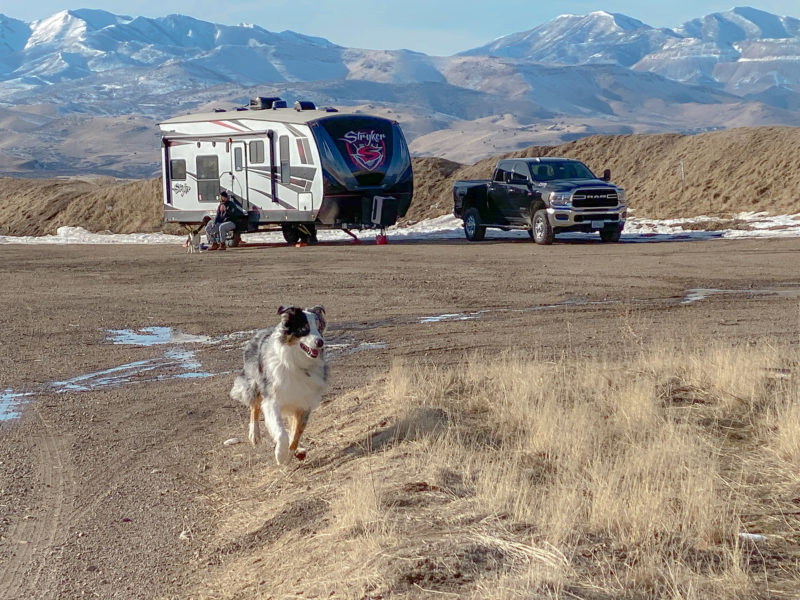
How to Find a Pet-Friendly Boondocking Location
Boondocking is a great way to give your pets a break from the confined space of an RV. When searching for boondocking spots, use the Campendium app or website to filter for “Pet-Friendly” camping locations. You can also read reviews to see what other campers say about the location in regards to pet rules and safety.
As a general rule, dogs are allowed on Bureau of Land Management land, in national forests, and on public lands; however, in developed recreational areas, pets must be leashed. Some of these sites may have more specific rules regarding leashes, so be sure to pay attention to websites and park signs, or call ahead.
Pets are allowed at most national parks in the U.S. in certain areas, but rules vary for each site. Visit the National Park Service’s website for leash regulations, pet-friendly trails and campsites, and more.
7 Campers Share What They Wish They Knew Before Boondocking
Safety Tips for Boondocking With Pets
While part of an animal’s safety when boondocking depends on its training and abilities, there are things that owners can do to ensure their pet’s safety and be prepared in case of an emergency. We asked veterinarians to weigh in on how to keep your animals protected when boondocking in the wilderness.

Can you leave your animal alone in your RV?
According to veterinarian Sarah Wooten DVM, CVJ at Pumpkin Pet Insurance, it’s safe to leave your pet alone while boondocking for a short period of time while adhering to a few guidelines.
- Only leave a pet in a hard-sided RV, not a soft-sided rig—bears and other wildlife predators can tear a soft-sided RV, like a pop-up trailer, and injure your pet. The exception to this rule is if you put up an electrified bear fence around the RV.
- Leave your pet securely contained in a proper crate. Don’t leave them loose inside your RV.
- If the temperatures are extreme, i.e. higher than 70 degrees or lower than 40 degrees for small or frail pets, or lower than 32 degrees for healthy, medium and large dogs, don’t leave them inside the RV unless you have the ability to control the temperature. Temperatures can quickly soar or plummet inside RVs, which can be harmful or even deadly for your animals.
- If your pet suffers from separation anxiety, or is an excessive barker or howler when left alone, it’s not recommended to leave them alone in an RV, whether you’re in a traditional campground or not.
- Leave enough pet food and water inside their crate to last until you return.
What vaccinations does a pet need before camping?
Dr. Wooten explains that it’s recommended to be current on core vaccines, including distemper/parvo and rabies. A bordetella (kennel cough) vaccine is a good idea if you’re going to be around other dogs or bringing them to a day or night boarding facility at any point. She also advises asking your vet about the parasite risks for the location you’re traveling to since “You might not have Lyme disease or heartworm where you live, but the area you’re camping at may be rife with it.” She recommends checking the maps at CAPC for updates on high-risk areas for parasites and viral diseases throughout the U.S.
In addition to a copy of current vaccine records, RVers should also bring along a photo of you and your pet together, recommends Lorraine Rhoads, an environmental biologist at Dogtopia. “This will help in identifying you as the pet parent as well as provide proof to the authorities of current vaccines in the event you and your furry family member are separated.”
How to Handle Vet Visits and Pet Care While Traveling
What medicines should pet owners pack for camping trips?
If your pet is on medication or a special diet, make sure you have enough before you head to your boondocking location, says Dr. Wooten. “If your dog gets car sick, ask your veterinarian for anti-nausea medication. If your dog gets stressed in the car, you can also ask your vet about calming aids or prescription-strength, anti-anxiety medication.”
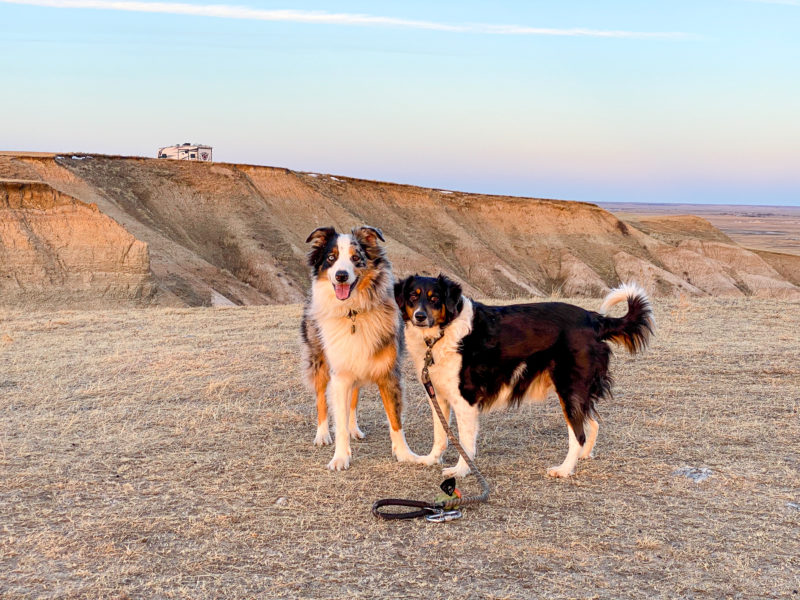
What other tips RVers should keep in mind while boondocking with pets?
When you first arrive at a boondocking area, do a thorough walk-through with your dog on a leash, advises Rhoads. This will help you identify any areas where native plants or wildlife could pose a risk to your pup. Be on the lookout for dangers such as mushrooms, poison oak, wild lilies, foxtail grass species, rattlesnakes, ticks, and skunk dens.
Here are a few more tips from Dr. Wooten to consider before taking your pup or cat along for a boondocking trip:
- Check your dog daily for burrs or foxtails (grass awns) that can become easily embedded in fur, especially in between toes. Also, check your dog for ticks or other external parasites.
- Don’t let your pets drink stagnant water or anything that has blue or green algae growing on it.
- Bears are attracted to food, so it’s recommended to use a bear box suspended a good distance from your site. Don’t keep food unattended around your rig.
- Tell somebody where you’re going and when you should be expected to return.
- Don’t let your pet chew on any dead animals.
- Avoid feeding your dog people food. If your dog has diarrhea or an upset stomach, you could be far away from help.
Gear for Boondocking With Pets
Being prepared with the right gear for your pet can be the difference between an enjoyable trip or a chaotic one. Veterinarian Chyrle Bonk, DVM at Hepper has a few recommendations when it comes to your packing list.

“The most important item you’ll want when traveling with your pet is proper identification. An ID tag on a secure collar or a microchip may be your pet’s ticket home should they get separated from you and lost,” she says. “Make sure your information is up-to-date on the tag or microchip as your phone number or address may have changed since it was issued.”
Dr. Bonk also suggests bringing extras of a few key items, “Pack an extra leash and collar should one become broken or lost, and bring extra water and pet food in case you don’t make it back when you expected to.”
Secrets to Successfully Camping With Dogs
Since water is a precious resource when camping off the grid, Georgina Ushi Phillips, DVM, advising veterinarian and writer for Not A Bully, advises on just how much water you need: “Dogs typically drink between 0.5 and 1 ounce of water per pound of body weight each day. If you’re boondocking and staying active, you can expect that to be on the higher end … you’ll want to bring additional water if your dog is prone to spilling when they drink, as many large breeds are.”
When boondocking and having your dog off-leash, Dr. Phillips also recommends using a GPS tracking collar and one that’s high-visibility or lights up. A flashlight, backup batteries, glow sticks, or reflective tape are also must-haves when boondocking, according to Rhoads.
And don’t forget about the weather—if you’re boondocking in lower temperatures, make sure your pet is warm enough with extra blankets or bedding for the crate, paw booties, and a coat.
Outside of typical gear like pet dishes, play toys, and lots of environmentally-friendly waste bags, here’s a list of items Dr. Bonk brings along when boondocking:
- Long lead to let them roam
- Clicker and/or plenty of treats for recall
- Boots or paw wax for rough terrain
- Extra towels for cleaning
- Bucket to collect pet waste bags outside of the RV
- Collapsible bowls and a portable pet water bottle
- Medical records for emergencies
- Pet first aid kit
Boondocking is more fun with pets, but to ensure everyone has the best experience, you should take the recommended precautions and be prepared with the right gear. Consider your pet’s abilities, personality, and recall skills in order to decide if boondocking is right for you and your furry friend. Your pet’s safety should always take priority, but with the right planning, you can enjoy epic boondocking adventures together.
